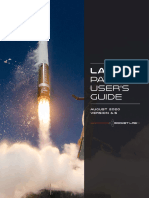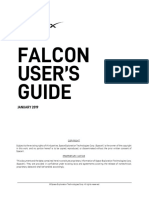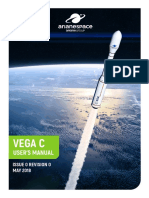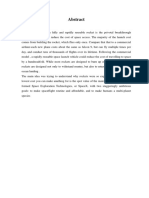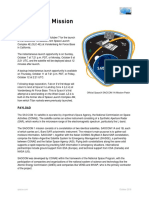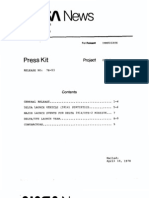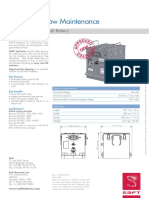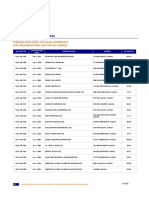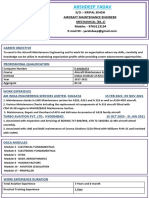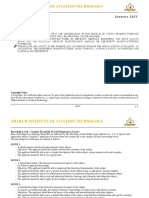Usersguide Zero
Uploaded by
adrianabarriosgarcia5Usersguide Zero
Uploaded by
adrianabarriosgarcia5VERSION 2.
0 | JULY 2024
ZERO - PAYLOAD USER’S GUIDE | VERSION 2.0 - JULY 2024 |
CHANGING
ROCKETS, SATELLITES,
AND FUTURE OF THE EARTH
Rockets: The Backbone of the Space Transportation Industry
Rockets serve as the only method of reaching orbit.
As a private space technology start-up, our focus is on designing cost-effective rockets
and providing space launch services to meet global demands.
VISION MISSION
Aspire to a future where the wonders of Empower the world with rocket solutions
space are accessible to all
REVISION HISTORY
Version Date Update
1.0 July 2023 First Release
2.0 July 2024 Updated Release
CONTACT
https://www.istellartech.com/en launch@istellartech.com
ZERO - PAYLOAD USER’S GUIDE | VERSION 2.0 - JULY 2024 | 2
CONTENTS
01 INTRODUCTION 04 FLIGHT ENVIRONMENTS
1.1 COMPANY PROFILE 4.1 NATURAL FREQUENCIES & DAMPING
1.2 VEHICLE OVERVIEW 4.2 QUASI-STATIC LOAD FACTORS
1.3 KEY COMPONENTS 4.3 RANDOM VIBRATION
1.4 COSMOS ENGINE 4.4 SHOCK
4.5 ACOUSTIC
02 PERFORMANCE 4.6 ELECTROMAGNETIC
4.7 FAIRING THERMAL ENVIRONMENT
2.1 FLIGHT PERFORMANCE
4.8 HUMIDITY
2.2 ORBIT INJECTION ACCURACY
4.9 VENTING
0 3 PAYLOAD ACCOMMODATION 05 LAUNCH SITE FACILITIES
3.1 FAIRING CAPACITY 5.1 ABOUT HOKKAIDO SPACEPORT
3.2 PAYLOAD COORDINATE FRAME 5.2 ACCESS
3.3 PAYLOAD CONFIGURATIONS 5.3 PAYLOAD PROCESSING FACILITY
& MECHANICAL INTERFACES 5.4 CUSTOMER OFFICE
3.3 ELECTRICAL INTERFACES
06 OPERATIONS
6.1 AVAILABLE SERVICES & EQUIPMENT
6.2 PAYLOAD PROCESSING WORKFLOW
6.3 MISSION & LAUNCH TIMELINE
6.4 MISSION PROFILE
07 ABOUT OUR COMPANY
7.1 TEAM
7.2 ACHIEVEMENTS
7.3 ADVANTAGES
ZERO - PAYLOAD USER’S GUIDE | VERSION 2.0 - JULY 2024 | 3
ACRONYMS
ICD Interface Control Document
LC-1 Launch Complex - 1
LEO Low Earth Orbit
LCH4 Liquid Methane
LOX Liquid Oxygen
MAXQ Maximum Dynamic Pressure
PSD Power Spectral Density
S1 Stage 1
S2 Stage 2
SPL Sound Pressure level
SSO Sun-Synchronous Orbit
VAB Vehicle Assembly Building
ZERO - PAYLOAD USER’S GUIDE | VERSION 2.0 - JULY 2024 | 4
ZERO - PAYLOAD USER’S GUIDE | VERSION 2.0 - JULY 2024 | 5
01 INTRODUCTION
1.1 C O M P A N Y P R O F I L E
Interstellar is a dynamic Japanese start-up with a vision of making space accessible to
everyone through low-cost and convenient space transportation services.
Headquartered in Taiki, Hokkaido, Interstellar's product development extends across five
locations, including branches in Tokyo, Fukushima, and Obihiro, as well as a laboratory at
the Muroran Institute of Technology.
Interstellar has achieved three successful spaceflights with suborbital launch vehicle
MOMO, making it Japan's first private company to reach space. Currently, Interstellar is
developing the orbital-class launch vehicle ZERO. Additionally, Interstellar leads Our
Stars, a satellite development project, pioneering Japan's vertically integrated
rocket-satellite service.
Location:149-7 Memu, Taiki, Hiroo-gun, Hokkaido, Japan
Representative:Takahiro Inagawa (Chief Executive Officer)
Main Office Welding Factory Main Factory
Tank Testing Facility Engine Testing Facility Propellant Storage Tanks
Control Center Machinery Tokyo Office
ZERO - PAYLOAD USER’S GUIDE | VERSION 2.0 - JULY 2024 | 6
01 INTRODUCTION
1.2 V E H I C L E O V E R V I E W
Interstellar's strength lies in its
comprehensive in-house capabilities for
design, manufacturing, testing, and
launch. By managing all development FAIRING
stages internally, Interstellar eliminates
HEIGHT : 5.0 m
unnecessary elements, accelerates
DIAMETER : 2.3 m
development and manufacturing, and
achieves significant cost reductions.
As a result of these streamlined 2nd STAGE
processes, Interstellar proudly introduces ENGINE x 1
ZERO, an orbital class launch vehicle.
PROPELLANT :
ZERO operates as an expendable
Liquid Methane + LOX
two-stage launch vehicle, using liquid
methane and liquid oxygen (LOX) as
propellants. It offers flexible space
transportation services, including
dedicated launches and ridesharing,
ensuring your satellite is placed into the
desired orbit on your preferred schedule.
1st STAGE
HEIGHT
ENGINE x 9
32 m / 1260 inch PROPELLANT :
Liquid Methane + LOX
DIAMETER
2.3 m / 90.6 inch
ZERO - PAYLOAD USER’S GUIDE | VERSION 2.0 - JULY 2024 | 7
01 INTRODUCTION
1.3 K E Y C O M P O N E N T S
1st STAGE ENGINE [x9]
1st STAGE
INTERSTAGE
2nd STAGE ENGINE [x1]
2nd STAGE
PAYLOAD ATTACH FITTING
FAIRING
AVIONICS
Reliable Systems for Mission Safeguarding
The avionics system serves a mission critical role in ZERO as it holds the responsibility of
monitoring and controlling the safety of the vehicle. The architecture, mechanical hardware,
electronic hardware, FPGA, and software development of the avionics system of ZERO are all
done in-house at Interstellar.
GIMBAL MECHANISM
Enhancing Mission Safety
Gimbal mechanism controls the direction of each engine and consequently the launch vehicle
trajectory and orientation. This allows engine adjustments mid-flight, improving safety for the
missions. This technology has been demonstrated in our suborbital launch vehicle MOMO.
PROPELLANT TANKS
Crafting High-Performance Tanks
Design, manufacturing, welding, and testing of the tanks are done at Interstellar.
High-strength aluminum alloy is used for the tanks that will store the liquid biomethane fuel
and liquid oxygen oxidizer. A proof and a burst pressure test were done to ensure its capability
to withstand design pressures and to gauge the pressure endurance limits.
ENGINE
Engine Systems Developed In-House
Interstellar adopted a liquid methane with liquid oxygen engine for ZERO. A cluster of 9 of the
same engines will be used on the first stage, and a single engine of the same design with a
vacuum optimized nozzle will be used on the second stage.
ZERO - PAYLOAD USER’S GUIDE | VERSION 2.0 - JULY 2024 | 8
01 INTRODUCTION
1.4 C O S M O S E N G I N E
GAS GENERATOR CYCLE & REGENERATIVE COOLING SYSTEMS
ZERO is a bipropellant rocket that uses
liquid bio-methane as fuel and liquid oxygen
as an oxidizer. This represents Interstellar's
first use of a gas generator cycle, where
part of the propellants is burned in a gas
generator to drive a high-speed turbopump.
This turbopump operates at tens of
thousands of rotations per minute,
delivering fuel to the combustion chamber
under high pressure. The rocket also
employs regenerative cooling, utilizing the
fuel to effectively cool the combustion
chamber walls.
The engine for ZERO has been named
COSMOS by the development team, inspired
by the COSMOS flower, the official flower of
Taiki. The engine's pintle injector spray
pattern resembles the petals of this flower,
making the name a fitting tribute.
CYCLE DIAGRAM LCH4
Turbopump Gas Generator
Propellant : LCH4, LOX
Engine Cycle : Gas Generator Cycle LCH4 Pump LOX Pump
Engine Cooling : Regenerative Cooling
Injector Type : Pintle Injector
LOX
Turbine
Turbine
Exhaust Port
Main Combustion
Exhaust
Chamber
Heat Exchange
Regenerative Cooling Line Pintle Injector
ZERO - PAYLOAD USER’S GUIDE | VERSION 2.0 - JULY 2024 | 9
01 INTRODUCTION
1.4 C O S M O S E N G I N E
HIGH-PERFORMANCE & SUSTAINABLE ROCKET FUEL for ENVIRONMENTALLY-CONSCIOUS LAUNCHES
Interstellar's rockets select liquid methane
as a fuel due to its high performance and
cost-effectiveness. Unlike traditional
rocket fuels like kerosene, which are toxic
and difficult to handle, liquid methane is
easier to manage. This makes it an excellent
choice for both rocket production and
operations. Additionally, using liquid
biomethane derived from cow manure
significantly contributes to carbon
neutrality. This initiative not only
addresses odor issues in Hokkaido's dairy
farming regions but also supports local
energy self-sufficiency, promoting
environmentally friendly development.
OPTIMIZED COST PERFORMANCE
Methane > Kerosene > Solid > Hydrogen
Advantages of
Methane
LOW ENVIRONMENTAL FOOTPRINT
Ocean : Methane <<< Kerosene
Atmosphere : Methane < Hydrogen < Solid
as Rocket Fuel
SUPERIOR SPECIFIC IMPULSE
Methane offers a higher specific impulse
than kerosene
ZERO - PAYLOAD USER’S GUIDE | VERSION 2.0 - JULY 2024 | 10
ZERO - PAYLOAD USER’S GUIDE | VERSION 2.0 - JULY 2024 | 11
02 PERFORMANCE
2.1 F L I G H T P E R F O R M A N C E
ZERO can carry payloads up to 800 kg to a mid-inclination Low Earth Orbit (LEO) at 561
km, while maintaining the flexibility to meet various payload and orbit requirements. In
the demanding Sun Synchronous Orbit (SSO), it can efficiently launch payloads of up to
250 kg at 561 km. Refer to the performance curve below for more detailed information.
Orbit LEO SSO
42.2°- 561 km 97.6°- 561 km
Payload Mass – 800 kg – 250 kg
ZERO uses Hokkaido Spaceport as its main
launch site. Facing the ocean to the east
and south, this location provides an
advantageous setting for accommodating a
wide range of inclination options.
Available Inclinations 42° – 98°
ZERO FLIGHT PERFORMANCE CURVE
ZERO - PAYLOAD USER’S GUIDE | VERSION 2.0 - JULY 2024 | 12
02 PERFORMANCE
2.2 O R B I T I N J E C T I O N A C C U R A C Y
The target injection accuracies of ZERO for a typical mission are as follows. These
estimates will be further refined with collected flight data.
Perigee ± 10 km
Apogee ± 15 km
Inclinations ± 0.1 deg
ZERO - PAYLOAD USER’S GUIDE | VERSION 2.0 - JULY 2024 | 13
ZERO - PAYLOAD USER’S GUIDE | VERSION 2.0 - JULY 2024 | 14
03 PAYLOAD ACCOMODATION
3.1 F A I R I N G C A P A C I T Y
The payload fairing of ZERO is designed to accommodate a wide range of payload sizes
and configurations, offering flexibility for various mission requirements. The
accompanying figure illustrates the dimensions and shape of this space. Detailed
specifications, including height, diameter, and overall volume, are provided to help you
optimize the integration of your payload.
∅
420mm
16.5 inch
∅
1,410 mm
55.5 inch
3,800 mm
∅ 149.6 inch
1,900 mm
74.8 inch 2,550 mm
100.4 inch
1,307 mm
51.5 inch
ZERO - PAYLOAD USER’S GUIDE | VERSION 2.0 - JULY 2024 | 15
03 PAYLOAD ACCOMODATION
3.2 P A Y L O A D C O O R D I N A T E F R A M E
The origin of the Payload Coordinate System is fixed at the center of the mechanical
interface between customer-supplied hardware and Interstellar-supplied hardware. This
coordinate frame is used for describing the flight environment conditions and
mechanical interfaces outlined in this document. The actual payload coordinate frame
will be further defined in the mission-specific ICD. For this purpose, assuming a standard
circular interface, the direction aligned with the launch is defined as the "Axial
Direction," while the orthogonal direction is defined as the "Lateral Direction."
Axial Direction
Launch Direction
Lateral Direction
ZERO - PAYLOAD USER’S GUIDE | VERSION 2.0 - JULY 2024 | 16
03 PAYLOAD ACCOMODATION
3.3 PAYLOAD CONFIGURATIONS & MECHANICAL INTERFACES
ZERO is capable of supporting various types of payloads, including small satellites and
CubeSats. A wide range of separation systems can be accommodated by tailoring the
bolt footprint of Interstellar-supplied hardware to match the customer-selected
separation system. Payloads can be arranged and fitted in different ways inside the
fairing to suit the specific requirements of each flight.
Please contact us if you have any questions or need assistance in selecting a separation
system.
Small Satellite x 1
Small Satellite x 1 Small Satellites x 4 CubeSats x 4
CubeSats x 5
ZERO - PAYLOAD USER’S GUIDE | VERSION 2.0 - JULY 2024 | 17
03 PAYLOAD ACCOMODATION
3.4 E L E C T R I C A L I N T E R F A C E S
Interstellar provides a flexible electrical interface tailored to accommodate diverse
payloads, separation systems, and dispensers. This interface typically includes
redundant payload deployment transmission signals and feedback signals to confirm
deployment status for standard missions. Specific details regarding the electrical
interface will be outlined in the mission-specific Interface Control Document.
Please reach out to us for confirmation of our ability to support your preferred deployer
hardware.
ZERO - PAYLOAD USER’S GUIDE | VERSION 2.0 - JULY 2024 | 18
ZERO - PAYLOAD USER’S GUIDE | VERSION 2.0 - JULY 2024 | 19
04 FLIGHT ENVIRONMENTS
The flight environments outlined below represent the expected maximum predicted
environments (MPE) for payloads in a typical mission. The loads and environments
provided in this section are for reference only. The actual mission-specific environments
will be detailed in the Interface Control Document (ICD) provided to customers.
For any questions about payload environments, please contact our team.
4.1 N A T U R A L F R E Q U E N C I E S & D A M P I N G
The purpose of defining natural frequencies and damping requirements is to ensure that
the payload’s elastic natural frequencies do not couple with those of the launch vehicle.
All elastic natural frequencies of the payloads must be above 40 Hz and must have a
quality factor (Q) between 10 and 50. These requirements are designed to adequately
account for the expected flight environments.
In this document, an elastic natural frequency refers to any frequency response of the
payload that involves modal participation, as determined by a fixed-base modal analysis.
Frequencies Requirements (Q=10~Q=50)
Axis Axial and Lateral
Frequency all modes above 40 Hz
ZERO - PAYLOAD USER’S GUIDE | VERSION 2.0 - JULY 2024 | 20
04 FLIGHT ENVIRONMENTS
4.2 Q U A S I - S T A T I C L O A D F A C T O R S
The payload will experience a range of acceleration loads in both the axial and lateral
axes during the flight, as shown in the graph below. This envelope includes static and
low-frequency dynamic loads.
Axial acceleration loads arise from thrust, aerodynamic axial forces, separation forces,
and similar factors. Lateral acceleration loads result from wind gusts, thrust vector
control (TVC) reaction forces, first-stage engine shutdown, and other short-term
events.
Mission-specific accelerations will be further detailed in the mission-specific Interface
Control Document (ICD), determined by the coupled loads analysis.
ZERO - PAYLOAD USER’S GUIDE | VERSION 2.0 - JULY 2024 | 21
04 FLIGHT ENVIRONMENTS
4.3 R A N D O M V I B R A T I O N
The plot below shows the estimated Maximum Predicted Random Vibration Environment
for microsatellite-class payloads. This estimate is based on an analysis of vehicle
environments and past data and is subject to change as additional flight information and
testing become available.
Frequency [Hz] 20 700 800 925 2000 GRMS
PSD [G^2/Hz] 0.01 0.01 0.03 0.03 0.00644 5.23
ZERO - PAYLOAD USER’S GUIDE | VERSION 2.0 - JULY 2024 | 22
04 FLIGHT ENVIRONMENTS
4.4 S H O C K
The maximum predicted shock response at the payload interface from all sources of
launch vehicle shock is shown in the graph and table. This level is defined assuming a
quality factor (Q) of 10. The estimate is based on an analysis of vehicle environments
and past data and is subject to change as additional flight information and testing
become available.
Frequency [Hz] 100 900 10000
Shock Response Spectrum [G] 50 700 700
ZERO - PAYLOAD USER’S GUIDE | VERSION 2.0 - JULY 2024 | 23
04 FLIGHT ENVIRONMENTS
4.5 A C O U S T I C
The vibroacoustic environment inside the fairing is determined as shown in the graph
and table below. This environment encompasses the acoustic vibrations generated by
the first-stage engine during lift-off, as well as the acoustic vibrations from pressure
fluctuations outside the vehicle during atmospheric flight. These conditions will be
redefined as more flight data becomes available.
MAXIMUM PREDICTED ACOUSTIC ENVIRONMENT
Frequency
31.5 40 50 63 80 100 125 160 200 250 315 400 500
[Hz]
SPL
121 122 123 124 124.9 125.7 126.3 126.7 126.9 126.6 126 124.8 123.6
[dB]
FREQUENCY
630 800 1000 1250 1600 2000 2500 3150 4000 5000 6300 8000 10000
[Hz]
SPL
122.2 120.9 119.3 117.5 115.5 113.6 111.9 110.1 108.4 106.5 104.6 102.8 101.1
[dB]
ZERO - PAYLOAD USER’S GUIDE | VERSION 2.0 - JULY 2024 | 24
04 FLIGHT ENVIRONMENTS
4.6 E L E C T R O M A G N E T I C
ELECTROMAGNETIC EMISSIONS FROM ZERO AND LAUNCH SITE
This section outlines the worst-case radiated emissions from the Launch Vehicle and
Launch Site. Payloads can expect to encounter an electric field (E-Field) from these
emissions, with levels no higher than those indicated in the graph and table below. The
electric field level is measured at the payload interface plane.
Components on payloads that are sensitive to RF environments should be verified for
compatibility with the specified radiated environment.
E-Field Radiation Emission vs Frequency
Label A B C D E F
Frequency Range [MHz] 0.014-18000 2025-2110 2200-2300 2401-2495 5230-5390 9410
E-Field Level [dBuV/m] 100 128 150 107 136 150
ZERO - PAYLOAD USER’S GUIDE | VERSION 2.0 - JULY 2024 | 25
04 FLIGHT ENVIRONMENTS
4.7 F A I R I N G T H E R M A L E N V I R O N M E N T
FAIRING TEMPERATURE AS SEEN FROM PAYLOAD
The temperature profile below shows the maximum fairing spot temperature seen by the
payload. The emissivity of the fairing is approximately 0.9.
FREE MOLECULAR HEATING
The Payload experiences a maximum free molecular aero-thermal heating rate of under
1135 W/m² at the point of fairing separation. This heating rapidly diminishes and
becomes insignificant within a few minutes.
ZERO - PAYLOAD USER’S GUIDE | VERSION 2.0 - JULY 2024 | 26
05 PAYLOAD ENVIRONMENTS
4.8 H U M I D I T Y
The maximum relative humidity inside the fairing from lift-off until just before fairing
separation is 65%. This controlled humidity level ensures the protection and integrity
of the payload during the initial phases of the flight. ZERO is designed to maintain
optimal environmental conditions, ensuring the successful deployment and operation of
the payload.
4.9 V E N T I N G
The graph below shows the pressure and decompression rate during flight for a typical
mission. The maximum depressurization rate is 1.9 kPa/s, with brief periods during flight
reaching up to 4.5 kPa/s for only 5 seconds.
Please note that these are preliminary values and are subject to refinement with
additional calculations and flight data.
ZERO - PAYLOAD USER’S GUIDE | VERSION 2.0 - JULY 2024 | 27
Provided by
: SPACE COTAN Co.,Ltd.
ZERO - PAYLOAD USER’S GUIDE | VERSION 2.0 - JULY 2024 | 28
05 LAUNCH SITE FACILITIES
5.1 A B O U T H O K K A I D O S P A C E P O R T
Hokkaido Spaceport (HOSPO) is the the
global commercial spaceport in East Asia,
located in Taiki, Hokkaido, Japan.
Situated at HOSPO, Launch Complex-1
(LC-1) serves as the designated launch site
for ZERO missions. LC-1 features a Vehicle Rendered Image
Assembly Building (VAB) and test facilities,
along with an exhaust duct to minimize
engine jet noise and vibration impact on
satellites. LC-1 is designed to blend
seamlessly with the surrounding natural
landscape.
5.2 A C C E S S
HOSPO is located in Taiki, southeastern
Tokachi Obihiro
Hokkaido Prefecture, easily accessible
Airport 40 min
from Tokyo within 2.5 hours. The by car
recommended route is to fly from Haneda
Airport to Tokachi Obihiro Airport in
Hokkaido, then drive to the launch site.
100 min
by plane
Tokyo International Airport
(Haneda Airport)
Provided by
: SPACE COTAN Co.,Ltd.
ZERO - PAYLOAD USER’S GUIDE | VERSION 2.0 - JULY 2024 | 29
05 LAUNCH SITE FACILITIES
5.3 P A Y L O A D P R O C E S S I N G F A C I L I T Y
The following illustrates the layout of the Payload Processing Facility at LC-1, featuring
the payload integration room, airlock, and dedicated customer office space. Please note
that as the facility is currently under construction, the final layout may slightly differ.
Maintenance
Room
Assembly Area Staff
Workspace
HVAC
Customer
Office
Gowning
Area
Cleanroom
Airlock
Unloading
Area
ZERO - PAYLOAD USER’S GUIDE | VERSION 2.0 - JULY 2024 | 30
05 LAUNCH SITE FACILITIES
5.4 C U S T O M E R O F F I C E
Interstellar provides an office area within the Payload Processing Facility, strategically
positioned adjacent to the payload integration area for convenient access. Although the
facility is currently under construction, the aim is to equip the office area with
essential amenities including Internet connection, air conditioning, and standard office
equipment such as desks, chairs, and phones.
ZERO - PAYLOAD USER’S GUIDE | VERSION 2.0 - JULY 2024 | 31
ZERO - PAYLOAD USER’S GUIDE | VERSION 2.0 - JULY 2024 | 32
6 OPERATIONS
6.1 A V A I L A B L E S E R V I C E S & E Q U I P M E N T
As part of our launch package, Interstellar offers a variety of services and equipment.
Some examples of what we can provide are detailed below. Recognizing the uniqueness
of each mission, the specific services and equipment will be finalized during the signing
of the Launch Services Agreement (LSA). We encourage early discussions during mission
planning to ensure that our offerings align with your schedule and budget.
SERVICES
・Dedicated Technical Mission Manager and Customer Support Teams
・Development and Provision of Mission-Specific Interface Control Document (ICD),
Including Verification Planning and Deliverables
・Mission Planning and Launch Scheduling
・Customization of Launch Configuration, Mechanical and Electrical Interfaces for
Dedicated Missions
・Progress Follow-Up Meetings
・Securing Necessary Launch Licenses from Japanese Authorities
・Guidance and Support for Launch Insurance
・Payload Transportation Assistance
・Interstellar Integration Support Personnel
・Accommodation Assistance for Customer's Launch Team
・Launch Site Access and Commute Support
・Photography Operations
・Confirmation of Payload Separation and Provision of State Vector to Customer
EQUIPMENT
・ISO-8 cleanliness level environment (Class 100K)
・Crane for payload integration operations
・Power provided for electrical ground support equipment (110V AC, 50Hz)
・Isopropyl Alcohol, wipes, gloves, hair nets, gowns, work shoes
・Security guards and video monitoring cameras
・Internet connection and standard office equipment for customer office
For information on additional services not listed above that may be required for your
mission, please contact our team.
ZERO - PAYLOAD USER’S GUIDE | VERSION 2.0 - JULY 2024 | 33
6 OPERATIONS
6.2 P A Y L O A D P R O C E S S I N G W O R K F L O W
This section provides an overview of the payload processing workflow for a typical
mission. A dedicated Interstellar integration team will be assigned to the customer,
working closely to provide comprehensive support throughout the process.
Payload Delivery to the Launch Complex
The payload will be transported from the customer's facility to our Launch Complex-1 in
Hokkaido. Upon arrival, our team will carefully offload and move the payload and ground
support equipment to the designated processing area. Typically, the payload arrives at
the launch site 30 days prior to launch, though this timeline can be adjusted if
necessary.
Payload Final Check-out
Customers will conduct the final checkout of the spacecraft, which involves performing
last-minute tests and preparations, such as software loading, powering up, and
propellant fueling. Our facilities offer all the necessary support to ensure your payload
is fully prepared and ready for integration.
Payload Integration
In this step, the payload will be integrated with the separation system, which will then
be attached to the payload attach fitting of the ZERO launch vehicle. This process also
includes establishing electrical and data connections to the launch vehicle, enabling
communication between the payload and our launch control team.
Fairing Encapsulation
At this stage, the payload, along with the separation system, is integrated with the
payload attach fitting. Once the payload is thoroughly checked, it will be encapsulated
within ZERO's fairing.
Encapsulated Payload Mate with ZERO Launch Vehicle
The encapsulated payload is then carefully transported to the assembly area for
integration with the rest of the launch vehicle. Once integrated, the launch vehicle,
with the payload onboard, will be ready to roll out to the launch pad.
ZERO - PAYLOAD USER’S GUIDE | VERSION 2.0 - JULY 2024 | 34
06 OPERATIONS
6.3 M I S S I O N & L A U N C H T I M E L I N E
The milestones and payload processing schedule for a typical mission are presented
below. If you require an accelerated or extended timeline, Interstellar will work closely
with you to develop mission-specific milestones.
To explore options for a customized timeline that aligns with your mission objectives,
please contact our team.
L-12months
Sign Contract & Mission Kick-off
L-6 months
Launch Campaign Planning Kick-off
L-3 months
Finalize ICD and Mission Interfaces
L-30 days
Payload Arrival at Processing Facility
Days Payload Launch Vehicle Launch Complex
S1, S2, and Fairing
L-30 Payload Integration Launch Pad and
Module Checkouts
Range Safety
L-15 Fairing Encapsulation Systems Checkouts
L-13 Encapsulated Fairing Mate with S1 and S2
L-10
Launch Vehicle and Range Interface Check RF Checkouts
L-4
L-3 Final Range
Final Launch Vehicle Preparation
L-2 Preparation
L-1 Roll Out
L-0 Launch LAUNCH
L+0 Deliver State Vector to Customer
ZERO - PAYLOAD USER’S GUIDE | VERSION 2.0 - JULY 2024 | 35
06 OPERATIONS
6.4 M I S S I O N P R O F I L E
The following illustration depicts the standard mission profile and staging sequence for
the ZERO rocket. While typical missions follow a similar profile, variations in timing and
altitude for key events may occur based on mission-specific requirements.
2nd engine 2nd engine 2nd engine
cutoff-1 start-2 cutoff-2
Fairing separation
2nd engine start-1
Payload
Stage separation deployment
Main engine
cutoff
MAX Q
Lift off
1 2 3 4 5 6 7 8 9 10
Main 2nd 2nd 2nd 2nd
Stage Fairing Payload
Lift off MAX Q engine engine engine engine engine
separation separation deployment
cutoff start-1 cutoff-1 start-2 cutoff-2
0
+ 62 + 143 + 148 + 153 + 192 + 429 + 3148 + 3149 + 3200
TIME [s]
ZERO - PAYLOAD USER’S GUIDE | VERSION 2.0 - JULY 2024 | 36
ZERO - PAYLOAD USER’S GUIDE | VERSION 2.0 - JULY 2024 | 37
07 ABOUT OUR COMPANY
7.1 T E A M
Interstellar's development team is made up
of highly skilled professionals, each with
extensive expertise and dedication. Our
engineers include those who have worked on
spacecraft development for Japan's
government space agency and experts from
leading global automobile manufacturers. By
merging Japan's industrial technologies,
Interstellar is pioneering a new era of space
exploration.
7.2 A C H I E V E M E N T S
18 ROCKET LAUNCHES
A total of 18 rockets have been manufactured and launched,
including three successful space missions. (as of June 2024)
FIRST IN JAPAN
The first rocket developed by a private Japanese company to
reach space.
FIRST IN THE WORLD
The first and only private company in the world utilizing
bio-methane liquid-fueled engine.
ZERO - PAYLOAD USER’S GUIDE | VERSION 2.0 - JULY 2024 | 38
07 ABOUT OUR COMPANY
7.3 A D V A N T A G E S
ON-DEMAND
Your Destination, Your Timeline
Interstellar facilitates on-demand transportation to the desired orbit and altitude, offering a
dedicated solution that overcomes the limitations of shared transportation for large satellites. By
integrating in-house design, manufacturing, testing, and launch operations, Interstellar significantly
reduces the time from contract to launch.
FLEXIBILITY
Tailored Solutions for Your Needs
In-house design and manufacturing capabilities grant flexibility to meet your needs. Interstellar
customizes the system to match your requirements and handle sudden changes, ensuring high
customer satisfaction.
LOW COST
Globally Competitive Launch Costs
Interstellar offers one of the most competitive price points in the microsatellite launch market.
Striving to reduce prices through the in-house development of core technologies and the active
utilization of cutting-edge technologies such as consumer-grade components and 3D printing.
VERSATILE LAUNCH SITE
Embrace the Allure of the Japanese Spaceport
Hokkaido Spaceport "HOSPO," located in Taiki, Hokkaido, Japan, provides launch capabilities towards
the east and south, making it one of the world's most suitable launch sites.
ZERO - PAYLOAD USER’S GUIDE | VERSION 2.0 - JULY 2024 | 39
ZERO PAYLOAD USER’S GUIDE
CONTACT SOCIAL MEDIA
launch
@istellartech.com
https://www https://yout @istellartech @interstellar https://www
.istellartech. ube.com/@is _en technologies. .linkedin.com
com/en tellartech inc /company/ist
ellartech/
ZERO - PAYLOAD USER’S GUIDE | VERSION 2.0 - JULY 2024 |
You might also like
- Relativity+Terran+1+Payload+User's+Guide Rev2.0100% (1)Relativity+Terran+1+Payload+User's+Guide Rev2.056 pages
- Rocket Lab Launch Payload Users Guide 6.5No ratings yetRocket Lab Launch Payload Users Guide 6.563 pages
- Space Trasportation Systems: Master Course For Graduate StudentsNo ratings yetSpace Trasportation Systems: Master Course For Graduate Students13 pages
- High Frontier Background Pp12 24 V2011!01!27lores 1No ratings yetHigh Frontier Background Pp12 24 V2011!01!27lores 113 pages
- Johnson 2023 - Preview - of - The - SpaceX - StarshipNo ratings yetJohnson 2023 - Preview - of - The - SpaceX - Starship11 pages
- Zero - Avia - A4 - Components Brochure - DIGITAL V3.3 US LETTER SIZE Up To Date With Print v3.4 3No ratings yetZero - Avia - A4 - Components Brochure - DIGITAL V3.3 US LETTER SIZE Up To Date With Print v3.4 37 pages
- © Space Exploration Technologies Corp. All Rights ReservedNo ratings yet© Space Exploration Technologies Corp. All Rights Reserved72 pages
- Star-Raker: An Airbreather/Rocket-Powered, Horizontal Takeoff Tridelta Flying Wing, Single-Stage-to-Orbit Transportation System - 1979100% (1)Star-Raker: An Airbreather/Rocket-Powered, Horizontal Takeoff Tridelta Flying Wing, Single-Stage-to-Orbit Transportation System - 197914 pages
- Sim Astronautics Astronautics 1960-09-5 9No ratings yetSim Astronautics Astronautics 1960-09-5 991 pages
- Personal Spaceship Operations Manual: Part No.: 83-3844-8 Last Updated: 1/28/20No ratings yetPersonal Spaceship Operations Manual: Part No.: 83-3844-8 Last Updated: 1/28/2030 pages
- Space Enthusiasts' Guide to Falcon HeavyNo ratings yetSpace Enthusiasts' Guide to Falcon Heavy7 pages
- Z2I BS TN 1 0316 R2 Bloostar Payload User GuideNo ratings yetZ2I BS TN 1 0316 R2 Bloostar Payload User Guide35 pages
- TechPort Report Download 11 - 05 - 2024 11 - 56 AM CETNo ratings yetTechPort Report Download 11 - 05 - 2024 11 - 56 AM CET4 pages
- Earth and Space Science - 2024 - Brown - Worldwide Rocket Launch Emissions 2019 An Inventory For Use in Global ModelsNo ratings yetEarth and Space Science - 2024 - Brown - Worldwide Rocket Launch Emissions 2019 An Inventory For Use in Global Models21 pages
- Emc Guideline For Payloads, Subsystems, and Components: Preferred Reliability PracticesNo ratings yetEmc Guideline For Payloads, Subsystems, and Components: Preferred Reliability Practices4 pages
- S4 Flyer Dynamic Bench Test Facility DatasheetNo ratings yetS4 Flyer Dynamic Bench Test Facility Datasheet1 page
- Angara Mission Planners Guide Rev 0 2002 12100% (1)Angara Mission Planners Guide Rev 0 2002 12288 pages
- RL SQC 202 Non Destructive Testing NDTRev1.0No ratings yetRL SQC 202 Non Destructive Testing NDTRev1.04 pages
- Evolved Expendable Launch Vehicle (Eelv) : RFP F04701-97-R-0008 19 June 1998 1No ratings yetEvolved Expendable Launch Vehicle (Eelv) : RFP F04701-97-R-0008 19 June 1998 144 pages
- ULM Ultra Low Maintenance: Nickel-Cadmium Aircraft BatteryNo ratings yetULM Ultra Low Maintenance: Nickel-Cadmium Aircraft Battery1 page
- Analysis For Case Study of Boieng Vs Airbus100% (1)Analysis For Case Study of Boieng Vs Airbus7 pages
- Organisation Approvals: Foreign Easa Part-145 Valid Approvals For Organisations Located in CanadaNo ratings yetOrganisation Approvals: Foreign Easa Part-145 Valid Approvals For Organisations Located in Canada8 pages
- Arshdeep Yadav: S/O:-Kripal Singh Aircraft Maintenance Engineer Mechanical (B1.1) Mobile: - 9765113154No ratings yetArshdeep Yadav: S/O:-Kripal Singh Aircraft Maintenance Engineer Mechanical (B1.1) Mobile: - 97651131542 pages
- The Sterile Cockpit Rule & FLight Crew BriefingNo ratings yetThe Sterile Cockpit Rule & FLight Crew Briefing2 pages
- Chapter 6 - Aircraft Weight Analysis - 2014 - General Aviation Aircraft DesignNo ratings yetChapter 6 - Aircraft Weight Analysis - 2014 - General Aviation Aircraft Design48 pages
- Dent and Buckle Chart Index: Report All Dimensions in InchesNo ratings yetDent and Buckle Chart Index: Report All Dimensions in Inches22 pages
- PDF Vol 10 Formato Inspeccion de Vivienda Octubre 26 CompressNo ratings yetPDF Vol 10 Formato Inspeccion de Vivienda Octubre 26 Compress8 pages
- I N - S e R V I C e A C T I V I T I e S R e P o R TNo ratings yetI N - S e R V I C e A C T I V I T I e S R e P o R T18 pages
- #1 - MPI - CZI 5539.3-3951-2013.pdf APD 08132025No ratings yet#1 - MPI - CZI 5539.3-3951-2013.pdf APD 081320254 pages



